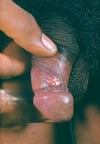Chancroid is a sexually transmitted infection caused by the bacteria Haemophilus ducreyi that causes painful sores on the genitals or in the mouth.
Chancroid is a sexually transmitted infection (STI) that is rare in the United States and other high-resource countries.
Chancroid is a common cause of genital sores (ulcers) in low-resource areas of Asia, Africa, and the Caribbean.
People who have chancroid (or other STIs that cause genital sores) are more likely to become infected with and to spread human immunodeficiency virus (HIV).
Haemophilus ducreyi may also cause ulcers to develop in areas other than the genitals, such as the mouth, breasts, inner thigh, and fingers.
(See also Overview of Sexually Transmitted Infections.)
Symptoms of Chancroid
Symptoms begin 3 to 7 days after infection. Small, painful blisters form on the genitals or around the anus and rapidly rupture to form shallow, open sores (ulcers) with ragged edges. These ulcers may enlarge and join together. Occasionally, ulcers become deeper and damage other tissues.
Image courtesy of Dr. Pirozzi via the Public Health Image Library of the Centers for Disease Control and Prevention.
Photo courtesy of Karen McKoy, MD.
The lymph nodes in the groin may form a bubo. A bubo is an enlarged and tender group of lymph nodes in the same area. Multiple buboes may form one large mass or in some cases form an abscess (collection of pus). The skin over the abscess may become red and shiny and may break down and discharge pus from the lymph nodes onto the skin.
Ulcers may also form in the mouth and on other areas of the skin.
Diagnosis of Chancroid
A doctor's evaluation
Sometimes nucleic acid amplification testing (NAAT) or culture of a sample of pus or fluid from a sore (ulcer) or bubo
Doctors suspect chancroid in people with one or more painful genital ulcers that have no obvious cause, especially if they are or have been in areas of the world where the infection is common.
Doctors can identify Haemophilus ducreyi by doing NAAT on a sample of pus or fluid from an ulcer or a bubo. NAAT is used to look for an organism's unique genetic material, its DNA or RNA (which are nucleic acids). NAAT uses a process that increases the amount of the bacteria's DNA or RNA so that it can be more easily identified.
If NAAT is not available, doctors take a sample of pus or fluid from an ulcer or a bubo and send it to a laboratory to be grown (cultured). However, culturing is less likely to identify these bacteria even when they are present, so the diagnosis relies more on symptoms and likelihood of being exposed to the infection.
People with chancroid are at high risk of syphilis and HIV infection, so if initial test results for these other infections are negative, doctors recommend that people with chancroid come back in 3 months after diagnosis to be tested again.
Treatment of Chancroid
An antibiotic
Several antibiotics, given by mouth (azithromycin, ciprofloxacin, or erythromycin) or as an injection (ceftriaxone), are effective for chancroid.Several antibiotics, given by mouth (azithromycin, ciprofloxacin, or erythromycin) or as an injection (ceftriaxone), are effective for chancroid.
If buboes are causing discomfort, doctors may make an incision to drain them. This treatment is done only if people are taking antibiotics to control the infection.
If sex partners have had sexual contact with the infected person during the 10 days before the person's symptoms began, they are examined and treated regardless of whether they have symptoms of chancroid.
Prevention of Chancroid
People can do the following to help reduce their risk of chancroid (and other sexually transmitted infections):
Practice safer sex, including using a condom every time for oral, anal, or genital sex.
Reduce the number of sex partners and not have high-risk sex partners (people with many sex partners or who do not practice safer sex).
Practice mutual monogamy or abstinence.
Vaccinate (available for some STIs).
Seek prompt diagnosis and treatment to prevent spread to other people.
Identify sexual contacts if infected with an STI for the purposes of counseling and treatment.
Drugs Mentioned In This Article



